The AMD Radeon R9 290X Review
by Ryan Smith on October 24, 2013 12:01 AM EST- Posted in
- GPUs
- AMD
- Radeon
- Hawaii
- Radeon 200
Meet The Radeon R9 290X
Now that we’ve had a chance to discuss the features and the architecture of GCN 1.1 and Hawaii, we can finally get to the hardware itself: AMD’s reference Radeon R9 290X.
Other than the underlying GPU and the livery, the reference 290X is actually not a significant deviation from the reference design for the 7970. There are some changes that we’ll go over, but for better and for worse AMD’s reference design is not much different from the $550 card we saw almost 2 years ago. For cooling in particular this means AMD is delivering a workable cooler, but it’s not one that’s going to complete with the efficient-yet-extravagant coolers found on NVIDIA’s GTX 700 series.
Starting as always from the top, the 290X measures in at 10.95”. The PCB itself is a bit shorter at 10.5”, but like the 7970 the metal frame/baseplate that is affixed to the board adds a bit of length to the complete card. Meanwhile AMD’s shroud sports a new design, one which is shared across the 200 series. Functionally it’s identical to the 7970, being made of similar material and ventilating in the same manner.
Flipping over to the back of the card quickly, you won’t find much here. AMD has placed all 16 RAM modules on the front of the PCB, so the back of the PCB is composed of resistors, pins, mounting brackets, and little else. AMD continues to go without a backplate here as the backplate is physically unnecessary and takes up valuable breathing room in Crossfire configurations.
Pulling off the top of the shroud, we can see in full detail AMD’s cooling assembling, including the heatsink, radial fan, and the metal baseplate. Other than angling the far side of the heatsink, this heatsink is essentially unchanged from the one on the 7970. AMD is still using a covered aluminum block heatsink designed specifically for use in blower designs, which runs most of the length of the card between the fan and PCIe bracket. Connecting the heatsink to the GPU is an equally large vapor chamber cooler, which is in turn mounted to the GPU using AMD’s screen printed, high performance phase change TIM. Meanwhile the radial fan providing airflow is the same 75mm diameter fan we first saw in the 7970. Consequently the total heat capacity of this cooler will be similar, but not identical to the one on the 7970; with AMD running the 290X at a hotter 95C versus the 80C average of the 7970, this same cooler is actually able to move more heat despite being otherwise no more advanced.
Moving on, though we aren’t able to take apart the card for pictures (we need it intact for future articles), we wanted to quickly go over the power and RAM specs for the 290X. For power delivery AMD is using a traditional 5+1 power phase setup, with power delivery being driven by their newly acquired IR 3567B controller. This will be plenty to drive the card at stock, but hardcore overclockers looking to attach the card to water or other exotic cooling will likely want to wait for something with a more robust power delivery system. Meanwhile despite the 5GHz memory clockspeed for the 290X, AMD has actually equipped the card with everyone’s favorite 6GHZ Hynix R0C modules, so memory controller willing there should be quite a bit of memory overclocking headroom to play with. 16 of these modules are located around the GPU on the front side of the PCB, with thermal pads connecting them to the metal baseplate for cooling.
Perhaps the biggest change for the 290X as opposed to the 7970 is AMD’s choice for balancing display connectivity versus ventilation. With the 6970 AMD used a half-slot vent to fit a full range of DVI, HDMI, and DisplayPorts, only to drop the second DVI port on the 7970 and thereby utilize a full slot vent. With the 290X AMD has gone back once more to a stacked DVI configuration, which means the vent is once more back down to a bit over have a slot in size. At this point both AMD and NVIDIA have successfully shipped half-slot vent cards at very high TDPs, so we’re not the least bit surprised that AMD has picked display connectivity over ventilation, as a half-slot vent is proving to be plenty capable in these blower designs. Furthermore based on NVIDIA and AMD’s latest designs we wouldn’t expect to see full size vents return for these single-GPU blowers in the future, at least not until someone finally gets rid of space-hogging DVI ports entirely.
Top: R9 290X. Bottom: 7970
With that in mind, the display connectivity for the 290X utilizes AMD’s new reference design of 2x DL-DVI-D, 1x HDMI, and 1x DisplayPort. Compared to the 7970 AMD has dropped the two Mini DisplayPorts for a single full-size DisplayPort, and brought back the second DVI port. Note that unlike some of AMD’s more recent cards these are both physically and electrically DL-DVI ports, so the card can drive 2 DL-DVI monitors out of the box; the second DVI port isn’t just for show. The single DVI port on the 7970 coupled with the high cost of DisplayPort to DL-DVI ports made the single DVI port on the 7970 an unpopular choice in some corners of the world, so this change should make DVI users happy, particularly those splurging on the popular and cheap 2560x1440 Korean IPS monitors (the cheapest of which lack anything but DVI).
But as a compromise of this design – specifically, making the second DVI port full DL-DVI – AMD had to give up the second DisplayPort, which is why the full sized DisplayPort is back. This does mean that compared to the 7970 the 290X has lost some degree of display flexibility howwever, as DisplayPorts allow for both multi-monitor setups via MST and for easy conversion to other port types via DVI/HDMI/VGA adapters. With this configuration it’s not possible to drive 6 fully independent monitors on the 290X; the DisplayPort will get you 3, and the DVI/HDMI ports the other 3, but due to the clock generator limits on the 200 series the 3 monitors on the DVI/HDMI ports must be timing-identical, precluding them from being fully independent. On the other hand this means that the PC graphics card industry has effectively settled the matter of DisplayPort versus Mini DisplayPort, with DisplayPort winning by now being the port style of choice for both AMD and NVIDIA. It’s not how we wanted this to end up – we still prefer Mini DisplayPort as it’s equally capable but smaller – but at least we’ll now have consistency between AMD and NVIDIA.
Moving on, AMD’s dual BIOS functionality is back once again for the 290X, and this time it has a very explicit purpose. The 290X will ship with two BIOSes, a “quiet” bios and an “uber” BIOS, selectable with the card’s BIOS switch. The difference between the two BIOSes is that the quiet BIOS ships with a maximum fan speed of 40%, while the uber BIOS ships with a maximum fan speed of 50%. The quiet BIOS is the default BIOS for the 290X, and based on our testing will hold the noise levels of the card equal to or less than those of the reference 7970.
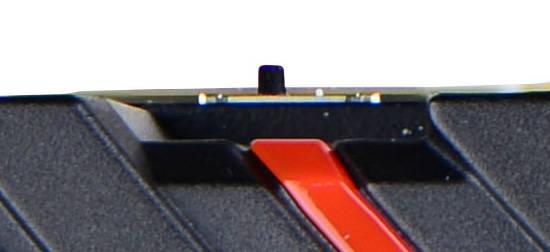
| AMD Radeon Family Cooler Comparison: Noise & Power | |||||||||||
| Card | Load Noise - Gaming | Estimated TDP | |||||||||
| Radeon HD 7970 | 53.5dB | 250W | |||||||||
| Radeon R9 290X Quiet | 53.3dB | 300W | |||||||||
| Radeon R9 290X Uber | 58.9dB | 300W | |||||||||
However because of the high power consumption and heat generation of the underlying Hawaii GPU, in quiet mode the card is unable to sustain its full 1000MHz boost clock for more than a few minutes; there simply isn’t enough cooling occuring at 40% to move 300W of heat. We’ll look at power, temp, and noise in full a bit later in our benchmark section, but average sustained clockspeeds are closer to 900MHz in quiet mode. Uber mode and its 55% fan speed on the other hand is fast enough (and just so) to move enough air to keep the card at 1000MHz in all non-TDP limited workloads. The tradeoff there is that the last 100MHz of clockspeed is going to be incredibly costly from a noise perspective, as we’ll see. The reference 290X would not have been a viable product if it didn’t ship with quiet mode as the default BIOS.
Finally, let’s wrap things up by talking about miscellaneous power and data connectors. With AMD having gone with bridgeless (XDMA) Crossfire for the 290X, the Crossfire connectors that have adorned high-end AMD cards for years are now gone. Other than the BIOS switch, the only thing you will find at the top of the card are the traditional PCIe power sockets. AMD is using the traditional 6pin + 8pin setup here, which combined with the PCIe slot power is good for delivering 300W to the card, which is what we estimate to be the card’s TDP limit. Consequently overclocking boards are all but sure to go the 8pin + 8pin route once those eventually arrive.


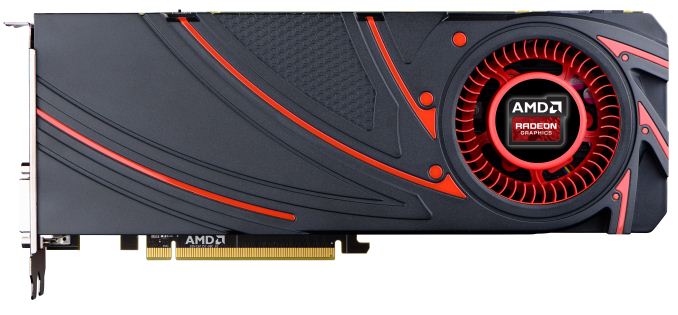
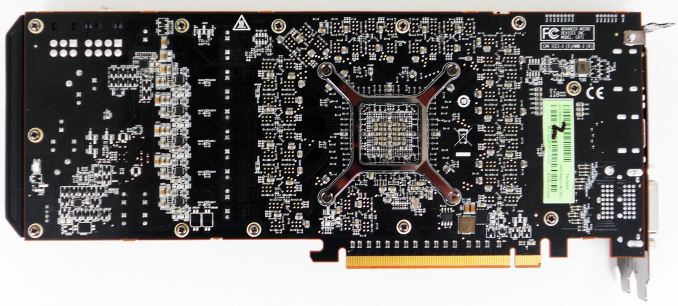
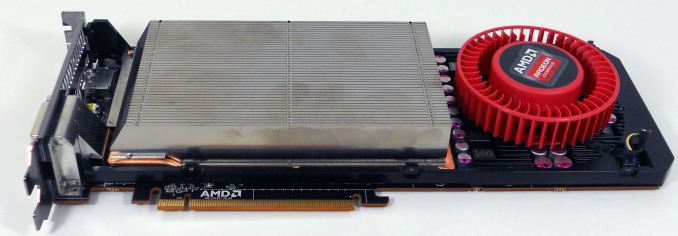
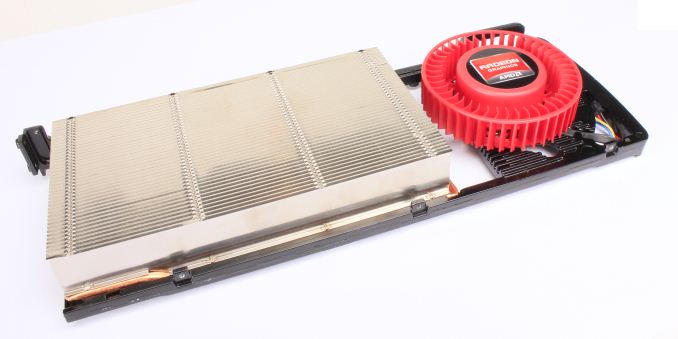

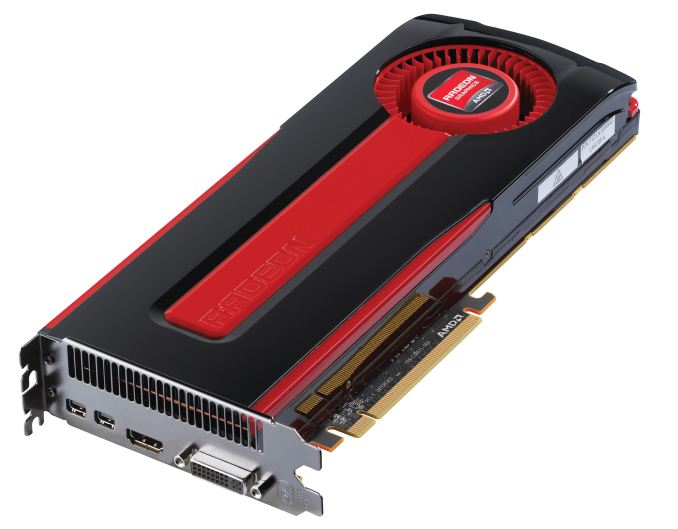
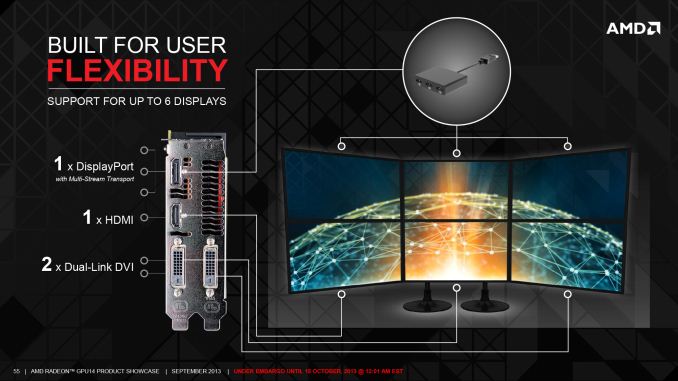








396 Comments
View All Comments
ninjaquick - Thursday, October 24, 2013 - link
so 4-5% faster than Titan?Drumsticks - Thursday, October 24, 2013 - link
If the 780Ti is $599, then that means the 780 should see at least a $150 (nearly 25%!) price drop, which is good with me.DMCalloway - Thursday, October 24, 2013 - link
So, what you are telling me is Nvidia is going to stop laughing- all- the- way- to-the-bank and price the 780ti for less than current 780 prices? Current 780 owners are going to get HOT and flood the market with used 780's.dragonsqrrl - Thursday, October 24, 2013 - link
Why is it that this is only ever the case when Nvidia performs a massive price drop? Nvidia price drop = early adopters getting screwed (even though 780 has been out for ~6 months now). AMD price drop = great value for enthusiasts, go AMD! ... lolz.Minion4Hire - Thursday, October 24, 2013 - link
Titan is a COMPUTE card. A poor man's (relatively speaking) proper compute solution. The fact that it is also a great gaming card is almost incidental. No one needs a 6GB frame buffer for gaming right now. The Titan comparisons are nearly meaningless.The "nearly" part is the unknown 780 TI. Nvidia could enable the remaining CUs on 780 to at least give the TI comparable performance to Titan. But who cares that Titan is $1000? It isn't really relevant.
ddriver - Thursday, October 24, 2013 - link
Even much cheaper radeons compeltely destroy the titan as well as every other nvidia gpu in compute, do not be fooled by a single, poorly implemented test, the nvidia architecture plainly sucks in double precision performance.ShieTar - Thursday, October 24, 2013 - link
Since "much cheaper" Radeons tend to deliver 1/16th DP performance, you seem to not really know what you are talking about. Go read up on a relevant benchmark suite on professional and compute cards, e.g. http://www.tomshardware.com/reviews/best-workstati... The only tasks where AMD cards shine are those implemented in OpenCL.ddriver - Thursday, October 24, 2013 - link
"Much cheaper" relative to the price of the titan, not entry level radeons... You clutched onto a straw and drowned...OpenCL is THE open and portable industry standard for parallel computing, did you expect radeons to shine at .. CUDA workloads LOL, I'd say OpenCL performance is all I really need, it has been a while since I played or cared about games.
Pontius - Tuesday, October 29, 2013 - link
I'm in the same boat as you ddriver, all I care about is OpenCL in these articles. I go straight to that section usually =)TheJian - Friday, October 25, 2013 - link
You're neglecting the fact that everything you can do professionally in openCL you can already do faster in cuda. Cuda is taught in 600+ universities for a reason. It is in over 200 pro apps and has been funded for 7+yrs unlike opencl which is funded by a broke company hoping people will catch on one day :) Anandtech refuses to show cuda (gee they do have an AMD portal after all...LOL) but it exists and is ultra fast. You really can't name a pro app that doesn't have direct support or support via plugin for Cuda. And if you're buying NV and running opencl instead of cuda (like anand shows calling it compute crap) you're an idiot. Why don't they run Premiere instead of Sony crap for video editing? Because Cuda works great for years in it. Same with Photoshop etc...You didn't look at folding@home DP benchmark here in this review either I guess. 2.5x faster than 290x. As you can see it depends on what you do and the app you use. I consider F@H stupid use of electricity but that's just me...LOL. Find anything where OpenCL (or any AMD stuff, directx, opengl) beats CUDA. Compute doesn't just mean OpenCL, it means CUDA too! Dumb sites just push openCL because its OPEN...LOL. People making money use CUDA and generally buy quadro or tesla (they own 90% of the market for a reason, or people would just buy radeons right?).
http://www.anandtech.com/show/7457/the-radeon-r9-2...
DP in F@H here. Titan sort of wins right? 2.5x or so over 290x :) It's comic both here and toms uses a bunch of junk synthetic crap (bitmining, Asics do that now, basemark junk, F@H, etc) to show how good AMD is, but forget you can do real work with Cuda (heck even bitmining can be done with cuda)
When you say compute, I think CUDA, not opencl on NV. As soon as you toss in Cuda the compute story changes completely. Unfortunately even Toms refuses to pit OpenCL vs. Cuda just like here at anandtech (but that's because both love OpenCL and hate proprietary stuff). But at least they show you in ShieTar's link (which craps out, remove the . at the end of the link) that Titan kills even the top quadro cards (it's a Tesla remember for $1500 off). It's 2x+ faster than quadro's in almost everything they tested. So yeah, Titan is very worth it for people who do PRO stuff AND game.
http://www.tomshardware.com/reviews/best-workstati...
For the lazy, fixed ShieTar's link.
All these sites need to do is fire up 3dsmax, cinema4d, Blender, adobe (pick your app, After Effect, Premiere, Photoshop) and pit Cuda vs. OpenCL. Just pick an opencl plugin for AMD (luxrender) and Octane/furryball etc for NV then run the tests. Does AMD pay all these sites to NOT do this? I comment and ask on every workstation/vid card article etc at toms, they never respond...LOL. They run pure cuda, then pure opencl, but act like they never meet. They run crap like basemark for photo/video editing opencl junk (you can't make money on that), instead of running adobe and choosing opencl(or directx/opengl) for AMD and Cuda for NV. Anandtech runs Sony Vegas which a quick google shows has tons of problems with NV. Heck pit Sony/AMD vs. Adobe/NV. You can run the same tests in both on video, though it would be better to just use adobe for both but they won't do that until AMD gets done optimizing for the next rev...ROFL. Can't show AMD in a bad light here...LOL. OpenCL sucks compared to Cuda (proprietary or not...just the truth).